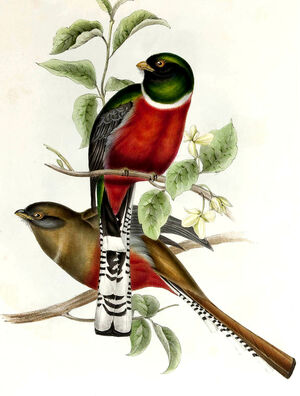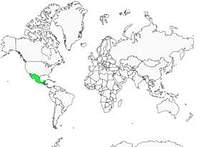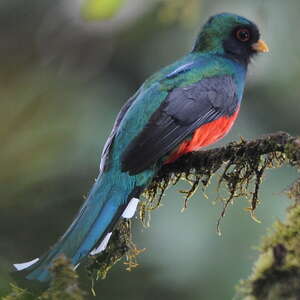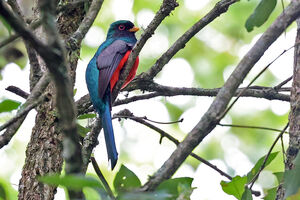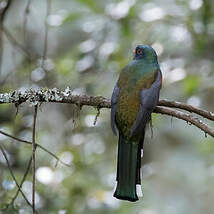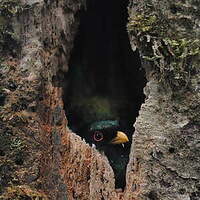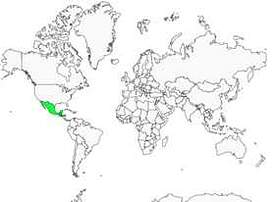Mountain Trogon
Trogon mexicanus - Trogon montagnard
Identification
The Mountain Trogon (Trogon mexicanus) measures 29 to 31 cm and can, of course, compete for the title of the most beautiful trogon! The dimorphism is pronounced, Mr. has a strong yellow beak surrounded by beautiful black vibrissae, the parotica are black and surround a dark brown iris surrounded by a red orbital circle, the crown, nape, mantle and back are green with bronze reflections. The green chest is separated from the bright red belly by a sharp white line, the scapulars are green while the covers have fine horizontal black and white vermiculations in the shape of waves. The black remiges are marked with white at the emarginations. The lower rectrices are black and have three large horizontal white bands that are the distinctive mark of the mountain trogon, the upper rectrices are green marked with a black line at its end. Mrs. is very different, yellow beak with black culmen, the parotica are gray as well as the throat, two white marks in front and behind the eye underscore this latter surrounded by a fine red orbital circle. The crown, nape and top of the chest are brown-fawn; two very clear white marks cross the thorax: below the first mark, the brown coloration changes to light brown, then a second white-gray design of elliptical shape separates the chest from the red belly to the pink nuances. The back, mantle and scapulars retain the fawn coloration, the covers have very fine brown vermiculations, the remiges are dark brown almost black with clear white emarginations. The lower rectrices are white divided into three parts and marked with black designs in the shape of lance points directed downwards, the outer edges being finely painted with short horizontal black lines; the upper rectrices resume the fawn hue of the back and end with a horizontal black line.Young Mountain Trogons look similar to their mothers, with a pale tawny color, and the scapulars and coverts have creamy-white scale-like markings. The beak is grey, and the eye-ring in young males is pale yellow. Identification can sometimes be difficult with Trogon elegans, which shares the same range; the lower rectrices will be the distinguishing element (wide black and white markings in Mountain Trogon mexicanus, fine black and white stripes with three white marks in Trogon elegans). Two subspecies are recognized, mexicanus as described previously to the south and east of Mexico, south of Guatemala and Honduras and north of El Salvador; subspecies clarus to the northwest of Mexico whose difference is visible (difficultly!) only in the female with patchy brown and a grayish-white throat, the tawny brown being lighter on the chest. The male is similar to mexicanus.
Subspecific information 2 subspecies
- Trogon mexicanus mexicanus (c Mexico to Honduras)
- Trogon mexicanus clarus (nw Mexico)
Foreign names
- Trogon montagnard,
- Trogón mexicano,
- surucuá-da-montanha,
- Bronzetrogon,
- Mexicaanse Trogon,
- Trogone montano,
- bergtrogon,
- Mexicotrogon,
- trogón horský,
- trogon mexický,
- Mexicotrogon,
- vuoritrogoni,
- trogon de muntanya,
- trogon górski,
- Горный трогон,
- メキシコキヌバネドリ,
- 高山美洲咬鹃,
- bergtrogon,
- 高山美洲咬鵑,
Voice song and call
Habitat
The Mountain Trogon loves pine-oak forests, typical of Mexico and the southern United States with higher humidity levels, which are a mix of various conifers such as Douglas fir, cypress, various firs and oaks. These forests grow from an altitude of around 900 to 3,500 meters and are often broken up by semi-desert areas, which explains for the most part why the Mountain Trogon's distribution range is discontinuous. It is rarely found below 600 meters and sometimes leaves the pine-oak forests for secondary forests or open areas. Several observations made by American ornithologists have shown that cohabitation between the Mountain Trogon and Elegant Trogon is frequent and that the latter tends to be located at higher altitudes in a drier environment.
Behaviour character trait
Generally the Mountain Trogon is sedentary, but various movements due to different reasons have been observed: searching for food, climate conditions and the reproduction period. From November to April during the dry and cold season it descends to lower coniferous forests and goes back up at the beginning of the rainy and reproduction season.
Dietfeeding habits
The Mountain Trogon is mainly insectivorous. Various larvae, lepidoptera, are captured from a branch or after a gliding flight. Occasionally it will eat fruits or berries but in smaller quantities.
Reproduction nesting
From April to June in Mexico and from March to May in Guatemala. American ornithologist Alexander Skutch (1904-2004) observed in 1942 groups of males vocalizing at the beginning of the reproductive period, similar to observations made of African Apaloderma Trogons. The nests are dug at the junction of trunks and large branches at a height of 1 to 12 m. Nesting observations are rare, Alexander Skutch identified a nest in 1933 with its entrance placed vertically, the tunnel measuring 20 to 29 cm high and 10 to 13 cm wide. These measurement differences came from the fact that the couple could not make their nest as they wished in the surrounding trees. The couple incubates 2 to 3 eggs in turn, mainly by the female, for 19 days. Both parents care for the feeding of the chicks which will leave the nest in 15 to 16 days.
Geographic range
Only found in northwestern Mexico (Chihuahua region); ssp mexicanus to the south in the regions of Durango and Tamaulipas, Mexico, to the south and center of Guatemala, and the center and south of Honduras. The Mountain Trogon is absent from the Yucatán, South Mexico and Belize. Several sightings have been reported near the Mexico-United States border.
Threats - protection
IUCN conservation status
concern
in the Wild
threatened
evaluated
The Mountain Trogon does not appear to be particularly in danger. It is classified as the most common trogon west of Guatemala.
Sources of information
- IOC World Bird List (v15.1), Gill, F and D Donsker (Eds). 2025-12-07.
- A Natural history of the Trogonidae, Joseph M.Forshaw Albert Earl Gilbert
- Vol. 6 - Handbook of the Birds of the World, Josep del Hoyo-Andrew Elliott-Jordi Sargatal
- xeno-canto, Sharing bird sounds from around the world,
- Avibase, Lepage Denis
- Neotropical Birds Online,
- Planet of Birds,
- Wikipédia, Wikipedia, The Free Encyclopedia
Other sources of interest
 Specification sheet created on
04/08/2023 by Anne et Gabriel Leboff
Specification sheet created on
04/08/2023 by Anne et Gabriel LeboffTranslation by AI Oiseaux.net
© 1996-2025 Oiseaux.net
- Accipitriformes
- Aegotheliformes
- Anseriformes
- Apodiformes
- Apterygiformes
- Bucerotiformes
- Caprimulgiformes
- Cariamiformes
- Casuariiformes
- Charadriiformes
- Ciconiiformes
- Coliiformes
- Columbiformes
- Coraciiformes
- Cuculiformes
- Eurypygiformes
- Falconiformes
- Galliformes
- Gaviiformes
- Gruiformes
- Leptosomiformes
- Mesitornithiformes
- Musophagiformes
- Nyctibiiformes
- Opisthocomiformes
- Otidiformes
- Passeriformes
- Pelecaniformes
- Phaethontiformes
- Phoenicopteriformes
- Piciformes
- Podargiformes
- Podicipediformes
- Procellariiformes
- Psittaciformes
- Pterocliformes
- Rheiformes
- Sphenisciformes
- Steatornithiformes
- Strigiformes
- Struthioniformes
- Suliformes
- Tinamiformes
- Trogoniformes

